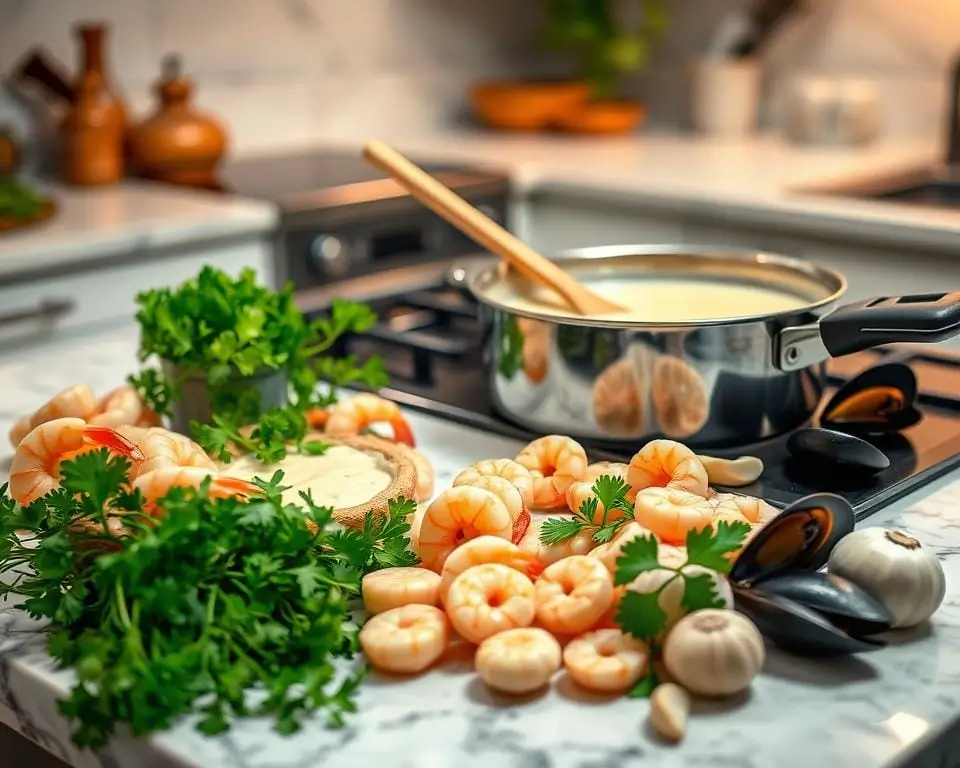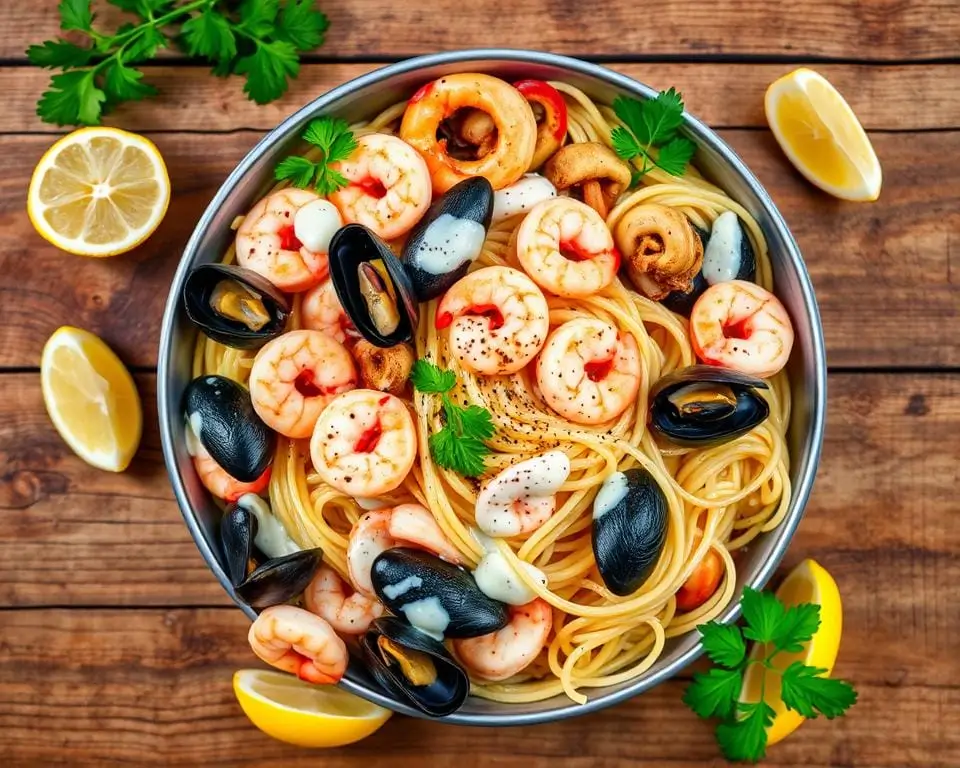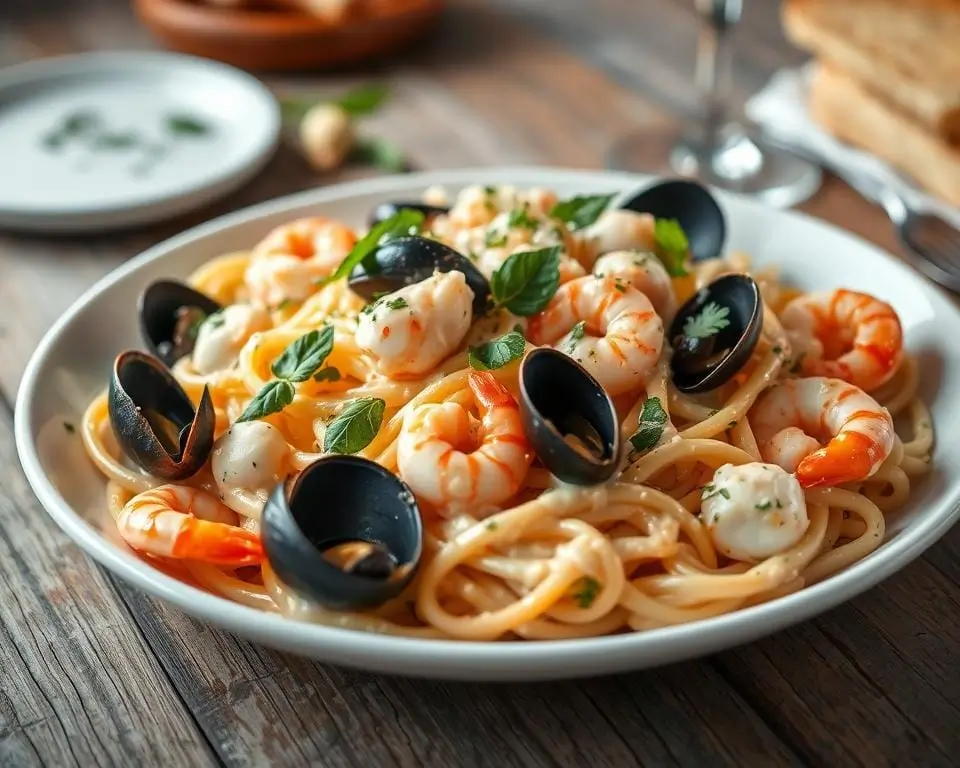How to Make the Perfect Seafood Pasta with White Sauce
The kitchen is my favorite place. Nothing makes a simple evening special like a delicious Pasta with seafood. Every time I make white sauce seafood pasta, I remember coastal dinners. I think of the salty breeze, the sound of wine glasses, and the excitement of that first bite.
Making the perfect shrimp linguine is more than cooking. It’s an art that turns simple ingredients into a dish fit for a restaurant. Whether you need a quick meal or a fancy dinner, this seafood linguine with white sauce will impress you.
Today, I’ll show you how to make a Seafood-inspired pasta dish. It has tender jumbo shrimp, al dente linguine, and a rich white wine sauce. It will take you to the Mediterranean coast with every bite.
Table of Contents
Essential Ingredients for Seafood linguine or spaghetti
Creating the perfect Pasta with seafood starts with choosing the right ingredients. These ingredients should blend flavors and textures well. They turn a simple dish into a memorable meal.
Fresh Seafood Options
High-quality seafood is key for dishes like lobster ravioli or crab fettuccine. Your seafood should include:
- Succulent shrimp
- Sweet crabmeat
- Tender mussels
- Briny clams
“The secret to extraordinary seafood pasta is choosing the freshest catch of the day.”
Pasta Varieties
Each pasta shape pairs well with seafood in its own way. For dishes like scallop pappardelle or mussel tagliatelle, try these:
- Linguine: Elegant and slim
- Fettuccine: Wide and robust
- Bucatini: Thick with a hole through the center
- Spaghetti: Traditional and versatile
White Sauce Base Components
A creamy white sauce makes your Creamy seafood linguine unforgettable. You’ll need:
- Unsalted butter
- Fresh garlic
- Heavy cream
- Aged Parmesan cheese
Pro tip: Add white wine, fresh lemon juice, and herbs for a richer taste.
Preparing Your Seafood Selection
Choosing the right seafood is key to a great calamari rigatoni or seafood linguine. Start by learning about fresh seafood and how to prepare it.
For anchovy bucatini, follow these cleaning and selection tips:
- Always check seafood for freshness before cooking
- Look for clear, bright eyes in fish
- Check for a clean, ocean-like smell
- Avoid seafood with strong fishy odors
Cleaning shellfish needs careful attention. Soak shellfish in cold, salted water for 10-15 minutes to remove sand and debris. For clams and mussels, gently scrub shells and carefully debeard mussels before cooking.
“Fresh seafood is the heart of an exceptional pasta dish” – Coastal Cuisine Expert
Different seafood types need different preparation methods:
- Shrimp: Use jumbo raw shrimp, thawed if frozen
- Mussels: Steam in white wine sauce for 5-7 minutes
- Clams: Cook until shells open completely
Pro tip: Throw away any shellfish that don’t open after cooking. This ensures food safety and the best flavor in your Seafood-inspired pasta dish.
Mastering the Creamy White Wine Sauce
Making the perfect pasta and seafood sauce needs focus and top-notch ingredients. Your seafood linguine will stand out with a creamy white wine sauce. This sauce makes the dish truly special.
The secret to a great sauce is choosing the right ingredients and balancing them well. Let’s look at what makes a pasta dish truly amazing.
Wine Selection Tips
Picking the right wine is crucial for your sauce. Go for crisp, dry white wines for a bright and deep flavor in your linguine seafood pasta. Here are some top picks:
- Sauvignon Blanc – bright and zesty
- Chardonnay – rich and buttery
- Pinot Grigio – light and refreshing
- Pinot Gris – subtle and elegant
Cream and Butter Ratios
The key to a creamy sauce is the right mix of ingredients. Heavy whipping cream gives it the luxurious feel you want. Here’s a guide:
- 1 cup heavy whipping cream
- 4 tablespoons unsalted butter
- 3/4 cup selected white wine
Seasoning Secrets
Enhance your pasta and seafood sauce with the right seasonings. They should match the seafood’s delicate flavors:
- Fresh minced garlic
- Chopped herbs like parsley, basil, or thyme
- Freshly ground black pepper
- Sea salt to taste
- A squeeze of fresh lemon juice
“The magic of a great sauce is in its simplicity and the quality of its ingredients.”
Pro tip: Add some grated Parmesan cheese to the sauce. It adds depth and thickens it a bit. Your homemade linguine seafood pasta will impress everyone.
Seafood linguine or spaghetti Cooking Techniques

Mastering seafood pasta white sauce needs precision and skill. Your journey starts with balancing cooking seafood and pasta perfectly. With just 15 minutes of prep, you can make a stunning shrimp linguine that will wow everyone.
“The art of seafood pasta is in the details of cooking technique”
Here are key cooking techniques for your seafood pasta white sauce:
- Use a large pot with generously salted water for cooking pasta
- Cook pasta al dente – typically 8-10 minutes for dried pasta
- Reserve 1/2 cup of pasta water to adjust sauce consistency
- Sauté shrimp quickly – 1-2 minutes per side to prevent overcooking
For the perfect seafood pasta white sauce, follow these expert tips:
- Heat olive oil in a large skillet
- Add minced garlic and red pepper flakes
- Quickly sear seafood at high temperature
- Deglaze pan with white wine for added flavor
A key tip for your shrimp linguine: cook seafood just until it turns opaque. Overcooking makes seafood tough and rubbery. The total cooking time should be around 10-12 minutes once all ingredients are combined.
Pro tip: Fresh seafood makes all the difference in your pasta dish!
Perfect Pasta Al Dente Guide
Cooking pasta for your linguine seafood pasta needs precision and skill. The secret to a great dish is knowing how to cook pasta al dente. This texture goes well with your pasta and seafood sauce.
Cooking pasta is more than just boiling water. You aim to make a perfectly textured base for your seafood dish.
Cooking Time Management
Professional chefs suggest a strategic pasta cooking approach:
- Always cook pasta 2 minutes less than package instructions
- Test pasta firmness by biting a strand
- Look for a slight resistance when chewing
Salt Water Ratios
Salt is key for flavor in your linguine seafood pasta. Follow these guidelines:
- Use 1-2 tablespoons of salt per pound of pasta
- Water should taste like seawater
- Add salt before adding pasta
Pasta Storage Tips
Proper storage keeps your pasta fresh for your next seafood sauce dish:
| Pasta Type | Storage Location | Maximum Storage Time |
|---|---|---|
| Dry Pasta | Cool, dry pantry | 1-2 years |
| Fresh Pasta | Refrigerator | 2-3 days |
| Cooked Pasta | Airtight container | 3-5 days |
“Pasta is the canvas, sauce is the art, and seafood is the masterpiece.” – Chef Mario Batali
Remember, practice makes perfect with your linguine seafood pasta. Each time you cook, you get better.
Combining Seafood and Pasta
Making the perfect seafood linguine needs care and love. You aim to mix the seafood’s light flavors with the pasta’s tender bite. It’s all about gentle mixing and smart techniques.

To make your clam spaghetti or lobster ravioli stand out, follow these steps:
- Toss the cooked pasta in the white wine sauce, ensuring an even coating
- Gently fold in the prepared seafood to prevent breaking delicate pieces
- Use reserved pasta water to adjust sauce consistency if needed
- Incorporate fresh herbs like parsley or basil for added brightness
Professional chefs have tips for each seafood type:
- Clams and mussels: Add them with their natural juices for maximum flavor
- Shrimp and scallops: Fold in carefully to maintain their tender texture
- Lobster: Break into chunks and distribute evenly throughout the pasta
“The art of Pasta with seafood is in the delicate balance of flavors and textures.” – Chef Marco Romano
Timing is key. Let the seafood and pasta mix for just a minute before serving. This short wait lets the flavors blend, making your dish unforgettable.
Garnishing and Presentation Tips
Creating a stunning seafood pasta dish is more than just cooking. The final touches can make your crab fettuccine or scallop pappardelle look like a work of art. Presentation is as important as flavor, making your dish feel like it’s from a restaurant.
Fresh Herb Enhancement
Boost your mussel tagliatelle with fresh herbs. The right herbs can make your dish look and taste better:
- Chopped parsley for bright green accents
- Delicate chive snippets for subtle onion notes
- Fresh basil leaves for aromatic complexity
Professional Plating Techniques
Learn to present your pasta like a pro with these tips:
- Use kitchen tongs to twirl pasta into elegant mounds
- Strategically place seafood around and atop the pasta
- Drizzle remaining white sauce in artistic patterns
Temperature and Serving Precision
Serving seafood pasta at the right time is key. Serve it immediately to keep it hot and fresh. Offer lemon wedges on the side, so guests can add a squeeze to taste.
“Great cooking is about creating an experience, not just a meal.” – Chef Anonymous
Your seafood pasta deserves a beautiful presentation. It will impress your family and guests alike.
Wine Pairing Suggestions
Finding the perfect wine can make your calamari rigatoni or anchovy bucatini even better. The right wine brings out the best in seafood pasta white sauce. It makes your meal a truly special experience.
Here are some top picks for wine with seafood pasta:
- Pinot Grigio: A crisp, light wine that pairs well with light seafood dishes
- Sauvignon Blanc: Offers herbal notes that boost seafood flavors
- Chardonnay: Provides a creamy texture that matches white sauce-based pastas
- Vermentino: Brings a Mediterranean coastal feel to your meal
Temperature matters! White wines should be chilled between 45-52°F. This brings out their flavors and refreshes your taste buds between bites.
“The right wine doesn’t just complement a dish; it transforms the entire dining experience.” – Culinary Wine Expert
For anchovy bucatini or calamari rigatoni, keep these tips in mind:
- Match the wine’s intensity with the seafood’s richness
- Think about the sauce’s complexity
- Balance acidity with creamy seafood pasta white sauce
Prosecco is a great choice for a sparkling twist. It cleanses your palate and adds fun to your seafood pasta celebration.
Storage and Reheating Guidelines
Keeping your shrimp linguine tasty means storing and reheating it right. Seafood pasta needs special care to keep its flavor and texture. With the right steps, your leftover pasta and sauce can still taste great.
- Refrigerate in an airtight container within 2 hours of cooking
- Store for a maximum of 3-4 days in the refrigerator
- Separate pasta from sauce if planning long-term storage
Reheating your pasta needs gentle care to avoid overcooking the seafood. Here are some tips to revive your dish:
- Stovetop method: Warm on low heat, stirring occasionally
- Add a splash of cream or milk to refresh the sauce
- Use medium heat to prevent drying out
“The secret to perfect reheated seafood pasta is low and slow heating.”
Freezing is another option for your seafood linguine. You can freeze pasta dishes for up to six months if done right.
| Storage Method | Duration | Best Practices |
|---|---|---|
| Refrigeration | 3-4 days | Use airtight container |
| Freezing | Up to 6 months | Separate sauce from pasta |
| Reheating | 15-20 minutes | Low heat, occasional stirring |
Pro tip: Always garnish with fresh herbs after reheating to restore vibrant flavors to your pasta and seafood sauce.
Conclusion
Making the perfect seafood pasta with white sauce turns a simple meal into a gourmet delight. Your cooking skills can make a classic dish stand out. It’s all about finding the right balance of flavors and techniques.
White sauce is the creamy base that holds everything together. Choose fresh, high-quality seafood like shrimp or scallops. The pasta you pick, like spaghetti or linguine, changes the dish’s feel.
Cooking is all about being creative and following your taste. Your seafood pasta can show off your cooking style. Try adding red pepper flakes for spice or fresh herbs for a twist.
Start with simple recipes and build your skills. Soon, you’ll make seafood pasta that wows everyone. Keep exploring and learning in the kitchen.

